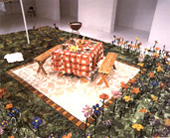- Exhibition program
- Cycle: Invisible Circles
- Artist
- Liza Lou
- Dates
- —
- Curated by
- Ferran Barenblit
"I am an artist and I am going to bead the world," says Liza Lou decidedly. She goes on to explain how she went to Italy at the age of 18 and was fascinated by the works of the old masters: constructions that needed the combined efforts of persons who gave their whole life to a single piece. She also saw how artists had painted the placid Tuscany countryside, an allegory in the open air with the balanced intervention of man. When she returned to the United States, she decided that she too wanted to build an alternative reality. But her own landscape was very different from that of the Renaissance artists. She had to find another form of expression, closer to the suburban landscape of California, to the all-night supermarkets and the garish colours.
This was how Liza Lou began to create objects out of glass beads. Her first work was The Kitchen, which took her five years. The items in it — made of papier maché and wood — were covered with beads, and not a single detail was lacking: the oven, the refrigerator, the table laid for breakfast, and even the dirty dishes from the night before.
When it was finished she started on The Back Yard, which in many ways represents the way of life in American suburbs with their detached houses. This time, however, she did not work alone but organized workshops where volunteers spent hours and hours helping to give shape to the blades of grass with millions of beads — a task that would have taken a single person about forty years to complete.
The Back Yard shows us another way of understanding our surroundings. It is a striking vision of uniform lifestyles, a trend that the rest of the world seems destined to follow. The use of such an unusual material makes us reflect on the limits that have traditionally been established between what is considered art and what is not, depending on the material used or the type of work. It is also a statement about the role to which women have traditionally been relegated: the thankless domestic tasks.
"Maybe I can’t change the world," says the artist, "but I can create what I want to look at."


